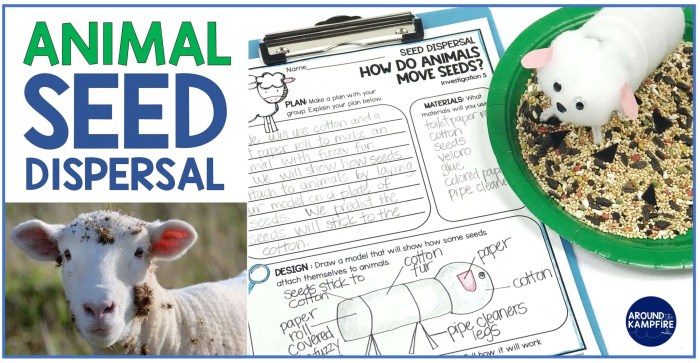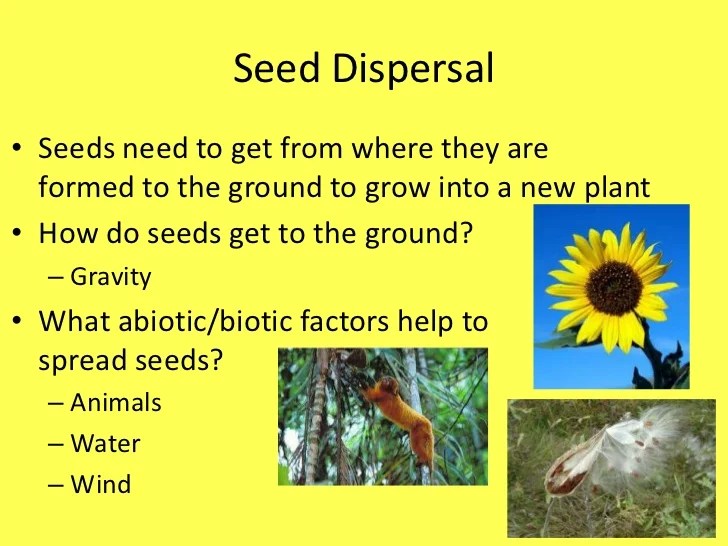How Are Plant Seeds Dispersed?
Seed Dispersal: Nature’s Ingenious Strategies: How Are Plant Seeds Dispersed

Source: aroundthekampfire.com
How are plant seeds dispersed – Seed dispersal is a crucial process for the survival and propagation of plant species. Without effective dispersal mechanisms, plants would be confined to their immediate vicinity, leading to increased competition for resources and a heightened vulnerability to environmental changes. Successful seed dispersal ensures the colonization of new habitats, genetic diversity within populations, and ultimately, the long-term survival of plant communities.
This exploration delves into the fascinating array of methods plants employ to spread their seeds, showcasing the remarkable adaptations that have evolved over millennia.
Introduction to Seed Dispersal
Seed dispersal mechanisms are incredibly diverse, reflecting the varied environmental pressures faced by different plant species. From the gentle sway of the wind to the powerful digestive systems of animals, plants have evolved a remarkable repertoire of strategies to ensure their seeds reach suitable germination sites. This diversity ensures the continuation of plant life and contributes significantly to the rich tapestry of plant life across the globe.
| Method | Description | Plant Examples | Advantages | Disadvantages |
|---|---|---|---|---|
| Wind Dispersal (Anemochory) | Seeds are carried by the wind. | Dandelions, Maple trees, Cottonwood | Wide dispersal range, colonization of new areas | Unpredictable dispersal, many seeds may not land in suitable locations |
| Water Dispersal (Hydrochory) | Seeds are carried by water currents. | Coconuts, Water lilies, Mangroves | Effective for dispersal across water bodies | Limited to aquatic or near-aquatic environments |
| Animal Dispersal (Zoochory) | Seeds are dispersed by animals. | Berries (e.g., raspberries, cherries), Burdock, Mistletoe | Targeted dispersal to suitable habitats, often with enhanced germination rates | Dependence on animal behavior, potential for seed predation |
| Ballistic Dispersal (Autochory) | Seeds are forcibly ejected from the plant. | Wood sorrel, Touch-me-nots, Geraniums | Relatively efficient dispersal in a localized area | Limited dispersal range, susceptibility to environmental factors |
| Human Dispersal (Anthropochory) | Seeds are dispersed by human activities. | Many agricultural crops, ornamental plants, invasive species | Rapid and widespread dispersal, colonization of new habitats | Potential for introduction of invasive species, disruption of native ecosystems |
Wind Dispersal (Anemochory)
Wind dispersal, or anemochory, is a common strategy employed by many plants. Seeds adapted for wind dispersal often possess lightweight structures, such as plumes or wings, that increase their surface area and allow them to be carried long distances by even gentle breezes. These adaptations maximize the chances of the seeds reaching a new location suitable for germination.
Examples include dandelion seeds with their fluffy parachutes, maple samaras with their characteristic wing-like structures, and cottonwood seeds with their cottony fibers. These morphological features enable the seeds to remain airborne for extended periods, increasing their chances of successful dispersal.
Infographic Description: The infographic would visually represent the diverse adaptations of wind-dispersed seeds. One section could show a dandelion seed with its parachute-like pappus, highlighting its large surface area for buoyancy. Another section could depict a maple samara, emphasizing its winged structure and the way it spins in the wind. A third section could showcase a cottonwood seed with its fluffy fibers, illustrating how these fibers increase the seed’s air resistance and allow it to float on the wind.
Water Dispersal (Hydrochory)
Water dispersal, or hydrochory, is a crucial strategy for plants inhabiting aquatic or near-aquatic environments. Seeds adapted for water dispersal typically exhibit features such as buoyancy, waterproof coverings, and the ability to withstand prolonged periods of immersion. These adaptations are essential for successful transport and survival during their journey across water bodies.
Plant seeds employ diverse dispersal methods, from wind-borne dandelion fluff to animal-assisted burrs. Understanding these mechanisms is crucial for successful cultivation, and this knowledge directly informs practices like those detailed in this guide on how and when to plant strawberry seeds. Ultimately, successful seed dispersal, whether natural or cultivated, ensures the continuation of plant life.
Examples include coconuts, whose tough outer shells protect the seed during long voyages across oceans, and water lilies, whose seeds float on the water’s surface until they find a suitable germination site. Mangrove seeds are another example; they germinate while still attached to the parent plant, then drop into the water and float to new locations.
- Buoyancy: Allows seeds to float on the water’s surface.
- Waterproof coverings: Protects the seed from water damage.
- Dormancy: Enables seeds to survive long periods of immersion.
- Salt tolerance: Essential for seeds dispersed in saltwater environments.
Animal Dispersal (Zoochory)
Animal dispersal, or zoochory, is a highly effective method of seed dispersal, relying on the movement of animals to transport seeds to new locations. This process involves various mechanisms, including ingestion, external attachment, and hoarding behavior. Plants have evolved a range of adaptations to attract animals and facilitate this dispersal.
Seeds dispersed through ingestion often have fleshy, nutritious fruits that attract animals. After the animal consumes the fruit, the seeds pass through their digestive system and are deposited in a new location along with the animal’s waste. Seeds dispersed externally often have hooks or barbs that allow them to attach to the fur or feathers of animals. Animals that hoard seeds, such as squirrels, may inadvertently disperse them by forgetting where they buried them.
The effectiveness of different animal dispersal methods varies depending on the animal’s mobility and foraging behavior. For example, birds can disperse seeds over long distances, while mammals may disperse seeds over shorter distances. The method also depends on the seed’s ability to survive digestion or its ability to attach to the animal.
Ballistic Dispersal (Autochory), How are plant seeds dispersed
Ballistic dispersal, or autochory, involves the forceful ejection of seeds from the parent plant. This mechanism is achieved through various adaptations, such as explosive seed pods that burst open when ripe, releasing seeds with considerable force. This method is particularly effective for dispersing seeds over short distances.
Examples of plants that utilize ballistic dispersal include touch-me-nots (Impatiens), which have seed pods that explode when touched, and wood sorrel, whose seed pods forcefully eject seeds when they dry out. The mechanism of ejection often involves changes in the seed pod’s structure as it matures, creating internal pressure that ultimately leads to the forceful expulsion of seeds.
- Advantages: Relatively efficient for short-distance dispersal, less dependence on external factors.
- Disadvantages: Limited dispersal range, susceptible to environmental conditions like wind direction.
Human Dispersal (Anthropochory)

Source: slidesharecdn.com
Human activities have profoundly impacted seed dispersal patterns, both intentionally and unintentionally. Intentional dispersal includes the cultivation and spread of agricultural crops and ornamental plants. Unintentional dispersal occurs through various means, such as the transport of seeds in soil, on clothing, or in vehicles. This has significant implications for plant distribution and biodiversity.
Agriculture and horticulture play a crucial role in the widespread dispersal of plant seeds. The cultivation of crops has led to the global distribution of many plant species, while the trade of ornamental plants has introduced numerous species to new environments. However, human-mediated dispersal can also lead to the introduction of invasive species, which can negatively impact native ecosystems.
Seed Dispersal and Environmental Factors
Environmental factors such as climate, topography, and soil type significantly influence seed dispersal patterns. For example, wind dispersal is more effective in open areas with strong winds, while water dispersal is limited to aquatic or near-aquatic environments. The effectiveness of animal dispersal depends on the presence and abundance of suitable animal vectors.
Plants have evolved various adaptations to cope with specific environmental conditions. For example, plants in arid environments may have seeds with thick coats that protect them from desiccation, while plants in areas with frequent flooding may have seeds that can withstand prolonged submersion. The interplay between seed dispersal mechanisms and environmental factors shapes the distribution and diversity of plant communities.
| Seed Dispersal Mechanism | Environmental Condition | Adaptation |
|---|---|---|
| Wind dispersal | Open, windy areas | Lightweight seeds, wings, plumes |
| Water dispersal | Aquatic or near-aquatic environments | Buoyancy, waterproof coverings |
| Animal dispersal | Areas with abundant animal vectors | Attractive fruits, hooks, barbs |
| Ballistic dispersal | Dense vegetation | Explosive seed pods |
FAQ Explained
What is the role of seed dormancy in dispersal?
Seed dormancy allows seeds to survive unfavorable conditions, such as drought or cold, until environmental cues signal optimal germination conditions. This enhances the chances of successful seedling establishment after dispersal.
How does seed size affect dispersal methods?
Seed size is a significant factor. Larger seeds are often dispersed by gravity or animals (e.g., through ingestion), while smaller seeds are more likely to be dispersed by wind or water.
Can seeds be dispersed by fire?
Yes, some plants have seeds adapted to fire; the heat triggers release or stimulates germination. This is known as pyrochory.
What is the impact of climate change on seed dispersal?
Climate change can alter dispersal patterns by affecting wind currents, rainfall, and animal migration, potentially impacting plant distribution and community composition.





















